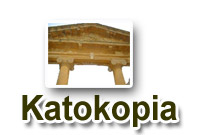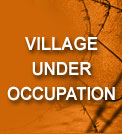Katokopia ( a village in Cyprus )
by Dr. George K. Michaelides
Position of Katokopia
Katokopia is situated in Morphou Area and in Nicosia District. The neighboring villages are: Zodia, Arghaki, Kyra, Massari, Avlona, Peristerona and Astromeritis.

The history of Katokopia
An ancient settlement existed in the area of Katokopia. The existence of stones is an indication of a ruined settlement.
The first known written reference related to Katokopia is from a Cypriot medieval manuscript of the monks of Asinou in 31st August 1318. According to this, Leon Kou(fas?) , who was the priest and judge of Katokopia and Zodia, died.
In another reference , the monks of Asinou, commemorate a property of theirs and mention that flaxes were destroyed in the area on the 16th of July of 1319.
According to Menelaos Christodoulou , a linguist, there is a reference to Zodokatokopia , that is to both the two villages Zodia and Katokopia together, because , perhaps, that time the villages were agricultural unities because of a common owner. It is also noteworthy that the agricultural works of that time did not differ from the works of the beginning of the 20th century, and that the cultivation of flax is typical of Morphou area.
The happenings of 1318 and 1319 are from the Paris code no. 1590.
They were written on the margins of an older medieval manuscript of 1063. The manuscript was found in Panayia Asinou in Cyprus.
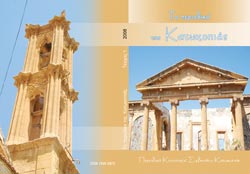
According to Goodwin, the name “Acopia” was perhaps the alteration of the name of Katokopia by the Franks. He considers that Katokopia existed since the 16th century or earlier.
Katokopia is in the lists of villages of the 15th century. According to Bruston ( 16th century ) katokopia is referred to as “Catokopia” village in 1464-1468. King Iacovos B’ of Cyprus, who reigned in the period 1460-1473, gave feuds to noble people. The owners of feuds in Katokopia were Gioan Ferrer, Gianes Sivalier and Margarita, fia de Franceschin de Bandes.
According to the report of Attar, a Venetian administrator, of the Venetian period ( beginning of the 16th century ) , katokopia is referred to as “Cacotopia”.
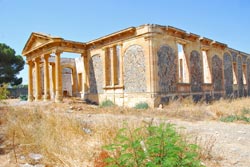
As to the existence of Katokopia in old maps, katokopia is referred to as “Corocopia” in the maps of Matheo Pagano (1538 ), Giovanni Francesco (1566 ) and Abraham Ortelius ( 1570 ).
Reference to “Acotope” in the map of Iacomo Franco ( 1570 ) and to “Acocopa” in the map of Abraham Ortelius ( 1573 ) is perhaps the alteration of the word “Katokopia”.
Gunnis mentions that the church of the village , dedicated to Panayia Chryseleousa, was renovated in 1818 , but frescos of the late 16th century were saved. These were the Resurrection of Lazaros and part of a gigantic representation of Archangelos Michael and also others.
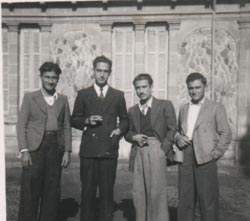
Katokopia is under Turkish military occupation since 1974.
The name of Katokopia
There are seven acceptations for the name of the village:
(a) It is produced from the words “kakos” ( =bad , stony ) and “topos” ( =place ), i.e. “kakotopia” and with the alternation of the consonants it takes today’s name.
(b) It comes from the words “kato” ( =down ) and “topos” ( =place ) , that is “katotopia-Katokopia”.
(c) It is from the root “kato-kopi” ( =to take the sheep down).
(d) During the Turkish Rule of Cyprus a young man escaped from the massacre of the Turks and ran from the village of Troullinos of Marathasa area and reached the area of Katokopia where he built a settlement. He was “katakopos” ( = very tired).
(e) The village was originally called “Kopia” and later, when it moved further down ( “kato” in Greek ), the name was changed to “Katokopia”.
(f) Some time in the past it was two villages, “Anokopia” ( note: “ano” means “up” ) which was destroyed and it was situated in Vounaroulia area, and “Katokopia”.
(g) Andreas Christodoulou ( from Katokopia ) discovered an old dictionary in which the word “kopia” means “much, very” and so the word “Kato-kopia” means “a place of very low altitude” and this is true compared to nearby places.

The population of Katokopia
In 1825 Katokopia had 38 inhabitants that were taxed and they were Greeks. According to the official censuses the population of the village increased from 301 in 1881 to 1578 in 1973. All inhabitants were Greek.
The churches of Katokopia

Katokopia has two churches dedicated to Panayia Chryseleousa, the old and the new. There is a reference to the old church in the section on the history of Katokopia.
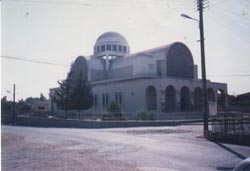
According to Charalambos Tooulos, who was born in 1915 and is a member of the ecclesiastical committee of Katokopia, the “golden” icon of Panayia Chryseleousa was very old, may be 400-500 years.
I had visited the old church of Katokopia on 24/4/2003 and on 28/4/2003. On the 24th of April the church was locked. I managed to see a destroyed fresco through a crack. There was filth on the floor. On the 28th of April the church was open. This time, the floor was clean. It was covered with a layer of concrete. There was nothing inside the church. Everything was missing. There were two destroyed frescos: one was on the left of the southern entrance and the other on the dome of the sanctuary. The inscription concerning the renovation of the church in 1904 was situated on the northern wall. The chronology 1818 was written on the southern wall. ( Note: The church was also renovated in 1818 ).
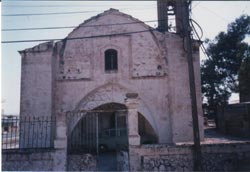
|
